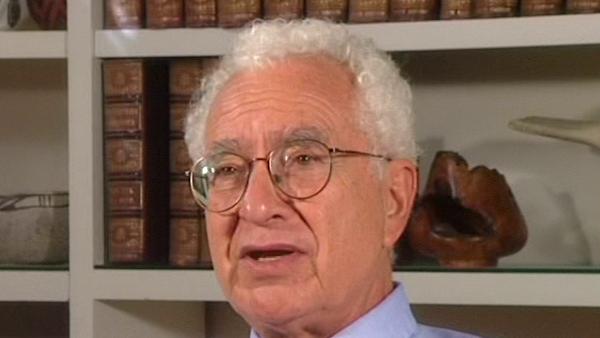NEXT STORY

Information overload. A crude look at the whole
RELATED STORIES

NEXT STORY

Information overload. A crude look at the whole
RELATED STORIES


|
Views | Duration | |
|---|---|---|---|
| 171. Early days at Santa Fe | 359 | 01:27 | |
| 172. Finding accommodation for the Institute | 326 | 01:47 | |
| 173. Achievements of the Institute | 370 | 04:07 | |
| 174. The future of the Institute. Models | 342 | 02:02 | |
| 175. Complex adaptive systems | 412 | 03:38 | |
| 176. Analytic work at Santa Fe. Integrative workshop | 298 | 01:38 | |
| 177. Gell-Mann's research: 1997 | 465 | 03:25 | |
| 178. Simplicity and complexity. Complex adaptive systems | 438 | 03:34 | |
| 179. Competition among different schemata | 372 | 02:51 | |
| 180. Information overload. A crude look at the whole | 403 | 04:42 |


Who or what decides what is... what are the regularities of something? Well, presumably a complex adaptive system, or as John Holland would call it, a... an adaptive agent. And that's something, some system that takes in a stream of data about itself and the rest of the world, compresses the observed regularities of those data into a... a compact, simple message... a compact message I should say, not necessarily so simple. A compact message, and then, usually in conjunction with further data from the data stream, makes out of that compact message a description or prediction of what happens in the world or a prescription for behavior of the system in the world. The results of that description, prediction or prescription of behavior in the real world then feed back to exert selection pressures on competition among these possible compressed messages. I call them schemata, John Holland would call them internal models. But whichever way you look at it, the internal model or schema has the chance of mutating or being replaced by another, so there is competition among different schemata. And the selection pressures exerted back by the real world effects on the competition cause the schema to evolve. So in biological evolution the schema would be the genotype, in the... the human scientific enterprise the schema would be a theory, in thought processes the schema would be an idea and so on and so forth. So it's a complex adaptive system really which determines... an observing complex adaptive system that determines what are the regularities and what features are treated as incidental in the description of something. The... the complex adaptive system doesn't have to be living, or even a part of a living thing, nor an aggregation of living things. It could be a computer, it could be a… a complex adaptive system on a computer. For an example, genetic algorithms, or neural nets, would be complex adaptive systems on computers. Living things would be biological evolution itself, organisms, parts of organisms like the immune system or the brain, aggregations of organisms, like a… a market composed of investors and so on and so on.
New York-born physicist Murray Gell-Mann (1929-2019) was known for his creation of the eightfold way, an ordering system for subatomic particles, comparable to the periodic table. His discovery of the omega-minus particle filled a gap in the system, brought the theory wide acceptance and led to Gell-Mann's winning the Nobel Prize in Physics in 1969.
Title: Competition among different schemata
Listeners: Geoffrey West
Geoffrey West is a Staff Member, Fellow, and Program Manager for High Energy Physics at Los Alamos National Laboratory. He is also a member of The Santa Fe Institute. He is a native of England and was educated at Cambridge University (B.A. 1961). He received his Ph.D. from Stanford University in 1966 followed by post-doctoral appointments at Cornell and Harvard Universities. He returned to Stanford as a faculty member in 1970. He left to build and lead the Theoretical High Energy Physics Group at Los Alamos. He has numerous scientific publications including the editing of three books. His primary interest has been in fundamental questions in Physics, especially those concerning the elementary particles and their interactions. His long-term fascination in general scaling phenomena grew out of his work on scaling in quantum chromodynamics and the unification of all forces of nature. In 1996 this evolved into the highly productive collaboration with James Brown and Brian Enquist on the origin of allometric scaling laws in biology and the development of realistic quantitative models that analyse the influence of size on the structural and functional design of organisms.
Tags: John Holland
Duration: 2 minutes, 52 seconds
Date story recorded: October 1997
Date story went live: 29 September 2010